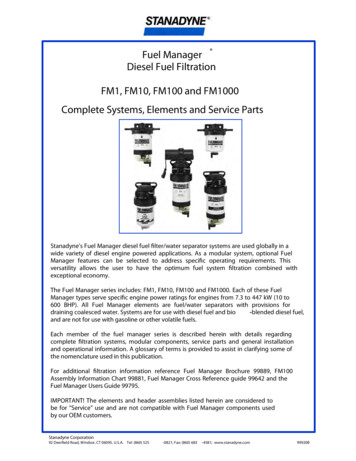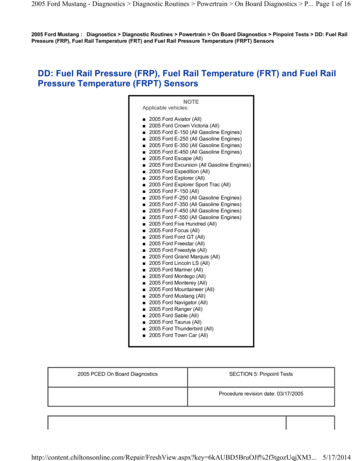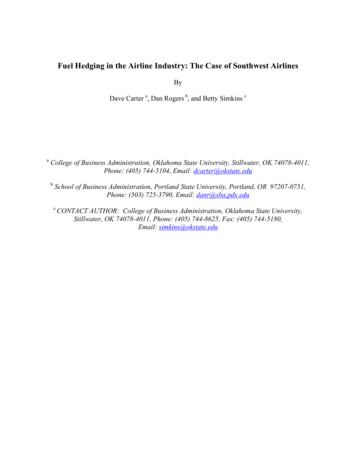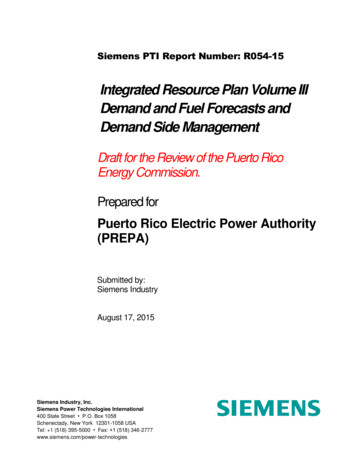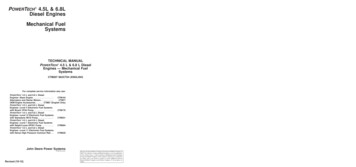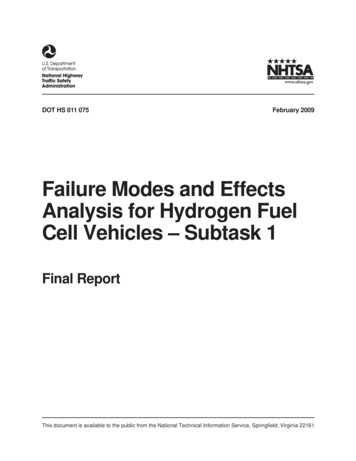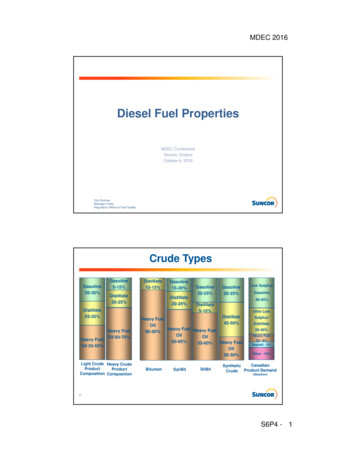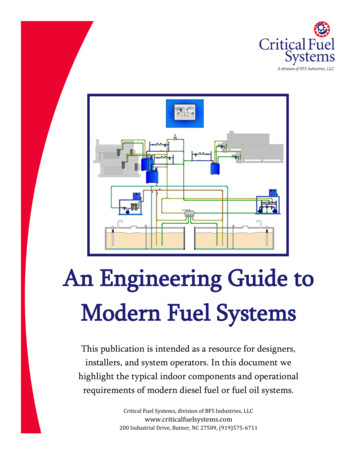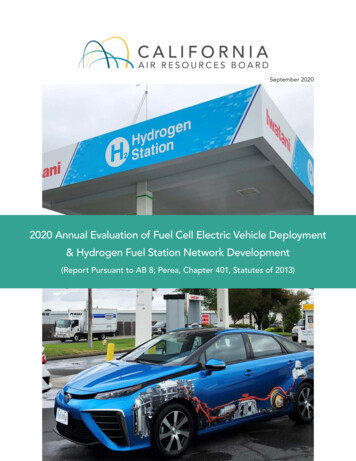
Transcription
September 20202020 Annual Evaluation of Fuel Cell Electric Vehicle Deployment& Hydrogen Fuel Station Network Development(Report Pursuant to AB 8; Perea, Chapter 401, Statutes of 2013)
Cover image courtesy of CaFCP.Courtesy of CaFCP. This report has been reviewed by CARB staff and approved for publication. Approval does notsignify that the contents necessarily reflect the views and policies of CARB, nor does mention oftrade names or commercial products constitute endorsement or recommendation for use.
CARB's mission is to promote and protect public health, welfare, andecological resources through effective reduction of air pollutants whilerecognizing and considering effects on the economy. CARB is the leadagency for climate change programs and oversees all air pollution controlefforts in California to attain and maintain health-based air quality standards.
ContentsAcronymsviH2 and FCEVs in the NewsviiiExecutive SummaryxiiiFindingsxvIntroductionStation Network ProgressEnergy Commission GFO 19-602 LaunchedAllocation of Volkswagen Environmental Mitigation Trust Funds to Hydrogen InfrastructureLCFS HRI Program UpdateHydrogen Fueling Network Self-Sufficiency Assessment Update234558Location and Number of Fuel Cell Electric VehiclesInformation Sources for FCEV ProjectionsAnalysis of DMV Registrations and Auto Manufacturer Survey ResponsesInsights for FCEV Deployment Potential from the BEV ExampleEnhanced Review of 2019 ProjectionsGlobal FCEV Markets and California’s Impact111112182326Location and Number of Hydrogen Fueling StationsCurrent Open and Funded StationsSuggestions for Future State Co-FundingStation Network Development with Respect to Industry Strategy MilestonesTrends of Station Deployment Rates2929374143Evaluation of Current and Projected Hydrogen Fueling CapacityAssessment and Projections of Hydrogen Fueling Capacity in CaliforniaRenewable Content of California’s Hydrogen Fueling Network464657Hydrogen Fueling Station Performance Standards and TechnologyUpdates to Fueling Protocol SAE J2601Standards and Test Methods Evolve to Aid Station Development595960Conclusions and Recommendations62References65Appendix A: AB 8 Excerpt70Appendix B: Station Status Summary72Appendix C: Auto Manufacturer Survey Material75Appendix D: Station Status Definition Details79
Courtesy of CaFCP
AcronymsAB 8Assembly Bill 8 (Perea, Chapter 401, Statutes of 2013)AHJAuthority Having JurisdictionBAAQMDBay Area Air Quality Management DistrictBEVBattery Electric VehicleCARBCalifornia Air Resources BoardCHATCalifornia Hydrogen Accounting ToolCHITCalifornia Hydrogen Infrastructure ToolDMVDepartment of Motor VehiclesEMFACCARB’s EMissions FACtor model used to assess emissions from on-road vehiclesEOExecutive OrderFCEBFuel Cell Electric BusFCEVFuel Cell Electric VehicleGFOGrant Funding Opportunity (California Energy Commission’s formal communicationof a current grant program)GO-BizGovernor’s Office of Business and Economic DevelopmentHGVHydrogen Gas VehicleHRIHydrogen Refueling InfrastructureHySCapEHydrogen Station Capacity EvaluationHyStEPHydrogen Station Equipment PerformanceIEAInternational Energy AgencyLCFSLow Carbon Fuel StandardNOPANotice of Proposed Award (California Energy Commission’s formal communication ofstaff recommendations for competitive grant awardees to be confirmed at an EnergyCommission Business Meeting at a later date)PHEVPlug-In Hybrid Electric VehicleSB 1505Senate Bill 1505 (Lowenthal, Chapter 877, Statutes of 2006)SOSSStation Operational Status System developed by California Fuel Cell PartnershipTCOTotal Cost of OwnershipUS DOEUnited States Department of EnergyZEVZero-Emission Vehicle
Courtesy of Shell
H2 and FCEVs in the NewsFCEV and Hydrogen Industry Announcements DemonstrateOngoing Commitment to FCEV Market Growth As early as July 2018, Toyota began publicly discussing its plans for the next phase of FCEVdeployment, including a newly designed Mirai and a phased introduction of a broader rangeof models including SUVs, pick-up trucks, and commercial trucks [1]. The first step in that planhas now begun, as Toyota unveiled the 2021 Mirai with a completely refreshed design. Thenew model adopts a sportier aesthetic and is based on Toyota’s premium rear-wheel drivecoupe platform. It is expected to provide 30 percent greater range than its predecessor anda more powerful, engaging, and quieter driving experience. The new model will also haveroom to seat five, an increase from the current version’s seating capacity of four (including thedriver and other passengers) [2]. Honda has made updates to its Clarity Fuel Cell for the 2020 model year. In addition to newcosmetic features and an improved pedestrian awareness system, the new model is notablefor improved performance in cold-weather conditions that could be especially helpful todrivers of its FCEV in northern California [3]. Auto manufacturer BMW has also revealed details of the FCEV powertrain that is expectedto be incorporated into its future iHydrogen NEXT vehicle, projected to be available inthe second half of this decade at the earliest. BMW reported that the fuel cell system willgenerate up to 125kw (equivalent to 170hp) with total system power of 275kW (374hp)provided by the fuel cell and a peak power battery. The vehicle will also carry six kilograms ofhydrogen onboard the X5-based vehicle [4]. Nikola Motor Company, which has recently been developing fuel cell and battery-poweredheavy-duty vehicles, also announced an upcoming entry into the light-duty vehicle market.The company announced that in 2020 it will unveil the Nikola Badger, the market’s first fuelcell-powered pickup truck (the Badger will also be available as a BEV). The announcementprojects a 0-60 mph acceleration time of 2.9 seconds, due to specifications of 906hp and 980ft.lbs. of torque. The Badger is expected to have an estimated 600 mile range, and the FCEVversion will be able to operate in blended FCEV/BEV or BEV-only modes; the BEV-only modeprovides 300 miles of range. The company expects to unveil the vehicle in September 2020and begin taking limited reservations [5]. Automotive components manufacturer Bosch announced that it is entering the FCEV marketby establishing a cooperative development agreement with Powercell, which is alreadyactive in the area of fuel cell stack development and manufacturing. The partnership willjointly develop fuel cell stacks and the technology will be made available for license in theautomotive market. Market entry is anticipated by 2022. Bosch foresees up to 20 percent ofthe electrified vehicle market powered by fuel cells in 2030 [6]. Hyundai has leveraged the international star power of Korean pop band BTS as brandsponsors for their fuel cell-powered NEXO. A marketing campaign titled “Because of You”features video recordings of the seven band members with personal messages abouthydrogen’s role in a sustainable future. The campaign debuted on Hyundai and the band’ssocial media accounts and in New York’s Time Square (BTS is popular around the worldincluding in the United States, where they were the first K-Pop group ever to win the BillboardMusic Awards trophy for best group in 2019. The band also arrived at the 2020 GrammyAwards presentation in a NEXO vehicle [7] [8] [9]. The latest edition of KPMG’s Global Automotive Executive Survey of emerging trends inthe automobile market continues to find strong emphasis on FCEVs. For the past five years,FCEVs have ranked in the top five key trends, peaking at number one last year and stayingviiiAnnual Evaluation of Fuel Cell Electric Vehicle Deployment & Hydrogen Fuel Station Network Development
at number three in the latest survey. The publication also found that automotive executivessee FCEVs making up 23 percent of the 2040 market, which is a composed of a roughly evensplit between FCEV, BEV, PHEV, and ICE technologies. KPMG also completed a survey ofconsumers, asking what powertrain they would choose if buying a car in the next five yearsand found that globally FCEVs share similar interest as BEVs, at nine percent and 12 percent,respectively. Within North America, customers slightly preferred the FCEV to the BEV at ninepercent and four percent, respectively [10].FCEV and Hydrogen Station Progress Continues Across the United States The Fuel Cell and Hydrogen Energy Association published a roadmap for the growth ofhydrogen-powered industry across all sectors, including transportation, residential andcommercial buildings, power generation, and industry feedstock and fuel. Highlight findingsinclude estimates that by 2030, hydrogen could provide one percent of total energy in theUS, and 100 percent of the necessary hydrogen could be produced domestically. The overalleconomic impact could be 140 billion in revenue and 700,000 jobs. By 2050, hydrogen couldgrow to 14 percent of total energy, remain 100 percent domestically produced, grow to 750billion in revenue and 3.4 million jobs while reducing CO2 emissions by 16 percent and NOx by36 percent [11]. On February 24, 2020, the New Jersey Assembly passed Assembly Bill A741, establishinga New Jersey Fuel Cell Task Force. The task force will be charged with developing a planto increase the use of fuel cells in the state of New Jersey and provide information andeducational resources towards that goal. The task force will also be charged with developingan infrastructure strategy to support the use of fuel cells [12]. The bill is currently under reviewin the state’s Senate. Energy solutions corporation and hydrogen station developer Iwatani Corporation of Americahas announced a collaborative agreement with electrolysis technology provider ITM Power.The agreement focuses on the deployment of multi-megawatt electrolyzer-based hydrogenenergy systems in North America. End users include transportation, energy storage, and therenewable energy sectors, with particular interest in California’s hydrogen fueling stationmarket and large-scale renewable hydrogen production for domestic use and export [13]. The Champaign-Urbana Mass Transit District in Illinois has awarded a contract for two FuelCell Electric Buses (FCEBs) to New Flyer for their sixty-foot Xcelsior CHARGE H2 transit buses.This is the first commercial order of 60-foot articulated fuel cell-powered buses. The busesare expected to enter service at the University of Illinois [14], [15]. Auto manufacturer Hyundai has entered a new research and technology demonstrationpartnership with the US Department of Energy, focused on fuel cell technologydemonstration and infrastructure testing under real-world operating conditions. Hyundai willadditionally provide five NEXO vehicles to the United States Department of Energy (US DOE)for testing across the United States and will also contribute to funding the installation of aSimpleFuel small-scale hydrogen fueling station in the Washington, DC area. (The SimpleFueldevice previously won the US DOE’s H2 Refuel H-Prize) [16].Annual Evaluation of Fuel Cell Electric Vehicle Deployment & Hydrogen Fuel Station Network Developmentix
FCEVs and Hydrogen Continue to Expand into Other Sectors alongsideLight-Duty Vehicles Heavy-duty engine and vehicle provider Cummins has advanced its entry into the fuel cellvehicle industry by acquiring fuel cell and hydrogen technology provider Hydrogenics.The acquisition will help Cummins launch product into commercial markets as vehicleelectrification continues to be adopted across the transportation sector [17]. Automakers Daimler and Volvo announced a new shared venture in developing andcommercializing fuel cell technology for heavy-duty and other applications. The new effortwill consolidate all of Daimler’s fuel cell activities into the newly formed joint venture. Theeffort is expected to reduce costs in development and production of the fuel cell systemsand accelerate market introduction. While the new venture is focused on heavy-duty vehicles,development for light-duty vehicles and other applications will continue within the venture[18]. In 2019, fuel cell provider PlugPower launched a new 30kw fuel cell system solution targetedfor delivery vans and light/medium cargo box trucks [19]. The ProGen 30kw engine hasnow been followed by the launch of a 125kw fuel cell solution for heavy-duty applications,including Class 6, 7, and 8 trucks, transit buses, and various port applications [20]. Automobile manufacturers Honda and Isuzu have reportedly launched a collaborative effortto develop hydrogen-powered trucks. The cooperation was born of Isuzu’s desire to expandits portfolio of powertrains for future heavy-duty applications combined with Honda’s aim toexpand the use of fuel cell technology into other sectors in support of a vision for a futurehydrogen society [21]. Mercedes-Benz’s innovation unit, Lab1886, has announced a collaborative pilot project withRolls-Royce Power Systems to demonstrate the application of automotive fuel cell systemsto stationary power systems. The project will focus on developing independent emergencypower systems for applications that currently rely primarily on diesel generators for backuppower, like data centers. The first units are expected to begin construction in early 2020 [22]. Horizon Fuel Cell Technologies, a Singapore-based provider of fuel cell power solutions,announced a Memorandum of Understanding with undisclosed partners to supply 1,000fuel cell units for heavy-duty applications. The fuel cell stacks are based on the company’sautomotive fuel cell technology and are all expected to be 100kW or greater in power.Delivery of the systems will occur over three years, with the first delivery scheduled for theend of 2019 [23]. Toyota and container terminal operator Fenix Marine Services launched the world’s firsthydrogen fuel cell electric Utility Tractor Rig (UTR) at the Port of Long Beach in 2019. TheTractor Rig is powered by the same fuel cell technology as the Mirai and is tied to Toyota’slarger Project Portal, which will also see the deployment of Class 8 heavy-duty trucks basedon Toyota’s fuel cell technology and the development of supporting hydrogen fuelinginfrastructure across Southern California [24]. Toyota has also begun demonstrating application of the fuel cell technology of its Mirai tostationary power. The company has installed a fuel cell system at its plant in Toyota City. Thesystem is based on the integration of two Mirai fuel cell stacks and a secondary battery. Theunit is expected to provide 24-hour power at 100kW to the company’s Honsha Plant [25]. Hyundai has announced its intent to develop a hydrogen-powered tram by 2022. Technologydevelopment is a shared venture between Hyundai Motor and Hyundai Rotem, the company’slocomotive subsidiary. The tram is expected to have a range of 200 km (124 miles) with amaximum speed of 70 km/hr (43 mph) [26].xAnnual Evaluation of Fuel Cell Electric Vehicle Deployment & Hydrogen Fuel Station Network Development
Electrolyzer equipment provider ITM Power has announced that it has secured the lease todevelop the world’s largest electrolyzer production facility. The company expected to enterthe building in March 2020 (an update has not yet been made publicly available). The facility,located in Sheffield, UK, will have an annual production capacity of 1GW per year [27]. The Orange County Transportation Authority recently opened the largest hydrogen fuelingstation in the United States to support the operation of 10 new FCEBs it purchased fromNew Flyer (though the station can support up to 50 buses). The station was built through apartnership between industrial gas company Air Products and Chemicals, Inc. and commercialfueling station operator Trillium. The project was organized by the Center for Technology andthe Environment and supported by funds from CARB’s Climate Investments program [28]. The San Bernardino County Transportation Authority recently announced that it has signeda contract to procure a hydrogen passenger locomotive for a new rail line currently underconstruction between Redlands and San Bernardino. The train could become the firsthydrogen-powered train in service in the United States when it enters service as early as 2024.The train will operate on the 9-mile route with capacity for 108 passengers and a top speednear 80 mph [29].Markets across the Globe Signal Rising Interest and Activity inHydrogen and FCEVs The German government has recently announced significant steps to strengthen its role inthe development of the global hydrogen industry and act as a world leader in the sector. OnJune 3, 2020, the German government announced a 130 billion economic recovery stimuluspackage that included 7 billion in investment to support market development of hydrogentechnologies for use domestically and an additional 2 billion for international partnershipsfocused on hydrogen. The investment plan envisions as much as 5GW of hydrogenproduction capacity, with a goal for 10GW total production capacity as early as 2035 but nolater than 2040. One week later, on June 10, 2020, the German government followed up withthe release of a new national strategy for investment in hydrogen technology and establisheda National Hydrogen Council to lead the effort [30] [31]. On June 17, 2020, Mitsui and Japan Bank for International Cooperation (JBIC) announcedinvestments of 25 million and 23 million, respectively, in California hydrogen fuelingstation developer and operator FirstElement. The investments are intended to strengthen anexisting investment and partnership between Mitsui and FirstElement to reduce costs andexpand business into new market opportunities. The announcement from JBIC meanwhilehighlighted that the funds will support Japanese FCEV manufacturers’ international effortsand competitive stance [32] [33]. The government of South Korea recently announced that it now plans to develop 1,200hydrogen fueling stations by 2040 as part of its strategy to cement hydrogen as the country’smain source of energy [34]. The Hydrogen Council recently published a new report assessing the cost-based marketcompetitiveness of hydrogen in a broad range of applications across sectors. The reportemphasizes the outsized role of growth in market scale to achieving necessary cost reductionsand finds that cost-competitive hydrogen is feasible in many applications by 2030. At 600,000vehicles produced per year, the report estimates that the Total Cost of Ownership forvehicles falls by 45 percent and that cost-competitiveness for many light-duty platforms couldoccur prior to 2030 or shortly thereafter. The report also estimates a worldwide investment(combined public and private) of 70 billion to achieve these goals [35]. As part of an effort to accelerate technology development and deployment in China, Toyotahas entered into an agreement to provide fuel cell components to Chinese auto makers FAWand Higer Bus. The components will be used to develop fuel cell-powered buses for theChinese market [36].Annual Evaluation of Fuel Cell Electric Vehicle Deployment & Hydrogen Fuel Station Network Developmentxi
A project to deploy and fuel the world’s largest fuel cell electric mining truck has recentlytaken shape in South Africa. Electrolyzer equipment supplier Nel ASA will provide a 3.5MWunit to be deployed to fuel a mining truck at a platinum mine operated by Anglo American.The truck will weigh 290 tons and incorporate a hybrid fuel cell-battery drive train with 1,000kWhr of energy storage onboard and capability for regenerative braking [37] [38]. The Australian government has approved the development of the world’s largest “HydrogenSuperhub,” a facility with 50MW of electrolysis capacity (up to 9,000 metric tons of hydrogenper year). The facility is meant to demonstrate the coordinated use of several renewableenergy technologies and includes 125MW of wind and 150MW solar electricity generationwith a 130MW Li-ion battery electric energy
GFO Grant Funding Opportunity (California Energy Commission’s formal communication of a current grant program) GO-Biz Governor’s Office of Business and Economic Development . has now begun, as Toyota unveil
